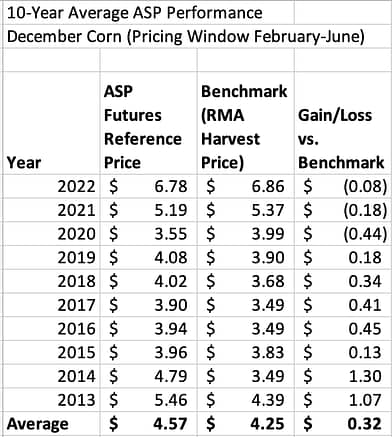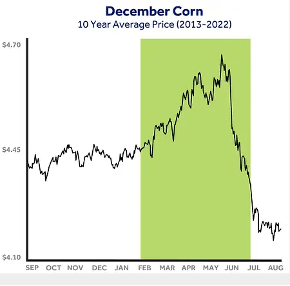Higher corn prices continue but for how long?
Following a strong two-year run, corn futures remain near the upper end of their historical price range. To protect these prices, producers can utilize a contract like the ASP to forward price a percentage of expected production during a seasonally strong time of year.
By taking advantage of an ASP contract, you will benefit from:
- Diversifying your grain marketing portfolio
- Leveraging an automatic execution component in your grain pricing program
- Capturing seasonal price advantages, rather than reactively selling on emotion
- Maintaining the control to “price out” if you see prices trending lower
The primary objective of any grain marketing strategy should be to protect and enhance farm profitability. Including ASP contracts in a marketing program has delivered a strong return on investment (ROI) over time, providing a challenging benchmark for other grain marketing alternatives in the mix.
The past
While past performance is no guarantee of future returns, the most recent 10-year period may prove instructive, especially if 2023 exhibits a more seasonal pattern.
From 2013-2022, the average return for the ASP contract compared to the harvest price is 32-cents/bushel (Table 1). This simply means that by sticking to this strategy over the years, a producer would have gained an average of 32-cents in the futures component of the price vs selling at harvest – that’s $64/acre if you raise 200-bushel corn.
Table 1: 10-year-average ASP performance

Chart 1: 10-year-average December corn futures price

This comparison shows the importance of a consistent strategy for gains over time, and a diversified grain marketing portfolio in years when the market doesn’t do what it “normally” does.
The future
According to USDA, 2023 is forecast to be a record year for corn production. Area planted to corn in 2023 is forecast at 92 million acres, up 3.4 million acres, or 3.8%, from 2022 and the highest since 93.3 million acres were planted in 2021. Corn production is forecast at a record-high 15.265 billion bushels with an average yield of 181.5 bushels per acre, both up from 13.93 billion bushels and 172.3 bushels per acre as of the November forecast for 2022.
No one knows whether corn prices will fall in 2023. They could continue higher on tight supplies and strong demand. But should USDA’s projections for record production hold true, it would likely pressure prices as the harvest situation becomes better understood later in the summer.
In statistical tables issued in advance of its annual Outlook Forum in February, USDA projected corn will sell for a season-average $5.00 in 2023.
The present
Given the USDA outlook and with corn futures currently near the top end of their historical range (Chart 2), protecting and capturing this price strength could be key to profitability in the new year. This is especially true given the expense side of the equation since input costs have risen significantly.
Chart 2: 59-year historical corn futures price (shaded areas indicate recessionary periods)

Producers can use an ASP contract to spread sales over months of uncertainty related to new-crop supply when prices tend to build in seasonal premiums to compensate for crop production threats. The contract allows sales over the entire period from February-June to determine a final price. But it also gives producers the flexibility to end the selling period early by pricing out of the contract at their discretion. For example, should market conditions deteriorate, a producer may decide to avoid potential further declines by capturing the average price to that point.
As with any forward pricing tool, ASP contracts should be used alongside corn marketing best practices to determine how much of the crop to price ahead. Some of these include:
- Know the breakeven to understand profit levels.
- Market up to amount of insurance coverage with a diversified approach.
- Bushels produced over the amount of insured coverage should be assessed as the crop year goes on. They can be priced ahead of harvest once the crop is made or held to be priced after harvest.
Get Started
ASP contracts require a 4-cent-bushel investment, and the deadline to enroll is January 20, 2023. Contact your ADM representative to enroll a portion of your expected production in a contract that works best for your operation and marketing objectives.
ADM is providing this communication for informational purposes, and it is not a solicitation or offer to purchase or sell commodities. The sources for the information in this communication are believed to be reliable, but ADM does not warrant the accuracy of the information. The information in this communication is subject to change without notice. If applicable, any information and/or recommendations in this communication do not take into account any particular individual’s or company’s objectives or needs, which should be considered before engaging in any commodity transactions based on these recommendations. ADM or its affiliates may hold or take positions for their own accounts that are different from the positions recommended in this communication.
